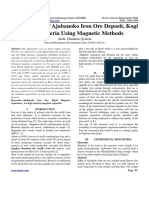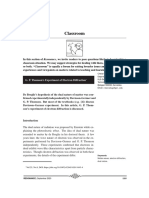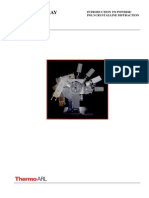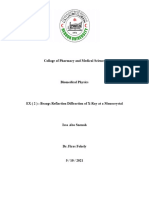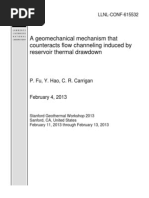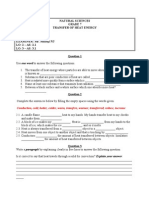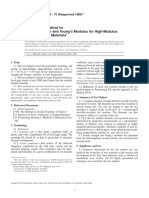Bragg Diffraction Experiment
Uploaded by
VedniveadBragg Diffraction Experiment
Uploaded by
VedniveadYear 12
Physics
Synchrotron
Bragg Diffraction Experiment
BACKGROUND THEORY Braggs Law derived in 1913 by the English physicists Sir W.H. Bragg and his son Sir W.L. Bragg to explain why crystals appear to reflect X-ray beams at certain angles of incidence. Bragg's Law: n = 2d sin
Where d is the distance between atomic layers in a crystal, is the wavelength in metres of the incident beam, is the angle of incidence; and n is an integer representing the number of wavelengths required for constructive interference to occur. At the smallest angle of incidence () for a maxima n = 1, at the next smallest angle n = 2, etc. Braggs Law is an example of X-ray wave interference or X-ray diffraction (XRD), and is used to determine the atomic structure of crystals. The Braggs were awarded the Nobel Prize in physics in 1915 for their work in determining crystal structures (NaCl, ZnS and diamond).
dsin d
dsin
Extra distance travelled by photon that enters the second layer is twice dsin = 2dsin. If this equals a whole number of wavelengths of the incident beam then constructive interference occurs. The reflected beam will be detected at a higher intensity.
Although Bragg's law was used to explain the interference pattern of X-rays scattered by crystals, diffraction has been developed to study the structure of all kinds of matter with a beam, as long as the wavelength used is comparable to the spacing of the molecules (or atoms) within the object under investigation. In this experiment microwaves will be used with a frequency roughly 1/50,000th lower than the X-rays the Braggs used. This will allow the measurement of crystal spacings 50,000 times greater than those found in compounds such as diamond or sodium chloride (NaCl).
Page 1 of 5
Year 12 APPARATUS Microwave transmitter and receiver Foam Crystal Large Protractor 2 1 metre ruler Aluminium barrier METHOD PART A
Physics
Synchrotron
1. Align one straight edge of the foam crystal along the base of the large protractor as shown in figure 1. 2. Place the aluminium sheet barrier on the 90o line of the protractor. 3. Place the microwave transmitter and receiver on the small blocks provided to raise them off the desk surface. 4. Point the microwave transmitter toward the face of the foam crystal at an initial angle of ~30o. Similarly align the receiver at 30o to the face of the foam crystal to detect the reflected beam. See figure 1. (Hint: using 1 metre rulers to align the receiver and transmitter can save considerable time in setting up) 5. Set the transmitter to the CW (continuous wave) and switch on. CAUTION: Never allow the transmitter to be directed towards a persons eyes at any time. Damage to the retinas is possible!
FOAM CRYSTAL
Figure 1
Transmitter
Aluminium sheild
Receiver
6. Switch the receiver on and use the gain control (1 4) to adjust the sensitivity of the meter. 7. Gradually move both the transmitter and receiver closer to the foam crystal face by reducing the angle. Ensure both devices are at the same angle at the same time. 8. Record any angles () when a marked increase is detected by the receiver. 9. Reset the apparatus as in steps 13 and repeat but gradually increase the value of this time. Each new peak will represent a value for n 10. Use Braggs Law to determine the spacing of the molecules in the foam crystal in this plane. 11. Repeat steps 19 with the foam crystal now placed on its side. See Figure 2. 12. Draw a 3-D model of the molecular structure of the foam crystal
Figure 2.
Original orientation of foam crystal
Alternate orientation of foam crystal on its side
Page 2 of 5
Year 12
Physics
Synchrotron
RESULTS Record the angle () at which maximum readings were recorded for each orientation of the foam crystal. Stop if = 90o. You do not need to fill in every line. Original Orientation n 1 2 3 4 5
Alternate (side) Orientation n 1 2 3 4 5
Calculations using Braggs Law to determine the spacing (d) of the molecules: d = n/2sin (microwave wavelength, = 2.8 cm) Original Orientation Alternate (side) Orientation
3-D Model of Foam Crystal
d1 d2
Page 3 of 5
Year 12 PART B Powder Diffraction
Physics
Synchrotron
1. Place the foam crystal in a cardboard or opaque plastic container, so that the orientation of the face cannot be seen. This container hides the direction of the face. 2. Place the container on the protractor randomly. Ensure that the foam crystal overlaps the straight edge. 3. Place the transmitter on the 0o line and put the aluminium barrier against the box edge on the 90o line again. 4. Move the receiver slowly from 0o towards 90o recording any angles of high intensity. 5. This time the angle recorded will equal 2. 6. Calculate the molecular spacing. 7. Predict which face of the foam crystal the transmitter is directed at. Use your answers from PART A to assist you. 8. Open the container and check your prediction.
CONCLUSION Which of the methods (Part A or B) was easiest to actually perform? Explain your choice.
Page 4 of 5
Year 12
Physics
Synchrotron
Page 5 of 5
You might also like
- InTech-Atomic Absorption Spectrometry AasNo ratings yetInTech-Atomic Absorption Spectrometry Aas13 pages
- Boolean Algebra: - Boolean Functions - Representing Boolean Functions - Logic Gates - Minimization of CircuitsNo ratings yetBoolean Algebra: - Boolean Functions - Representing Boolean Functions - Logic Gates - Minimization of Circuits24 pages
- Beneficiation of Ajabanoko Iron Ore Deposit, Kogi State, Nigeria Using Magnetic MethodsNo ratings yetBeneficiation of Ajabanoko Iron Ore Deposit, Kogi State, Nigeria Using Magnetic Methods3 pages
- Advanced Physics Laboratory XRF X-Ray Fluorescence: Energy-Dispersive Analysis (EDXRF)No ratings yetAdvanced Physics Laboratory XRF X-Ray Fluorescence: Energy-Dispersive Analysis (EDXRF)14 pages
- Chapter 3: Crystal Structures: X-Ray Diffraction (XRD)No ratings yetChapter 3: Crystal Structures: X-Ray Diffraction (XRD)31 pages
- Classroom: G. P. Thomson's Experiment of Electron Di FfractionNo ratings yetClassroom: G. P. Thomson's Experiment of Electron Di Ffraction4 pages
- Experiment 8: Light As A Wave (Diffraction Grating)No ratings yetExperiment 8: Light As A Wave (Diffraction Grating)6 pages
- Lab 4: Diffraction Gratings and Prisms (3 Lab Periods) : Revised VersionNo ratings yetLab 4: Diffraction Gratings and Prisms (3 Lab Periods) : Revised Version7 pages
- FEM Acoustic Analysis - NDT Angle Beam ExampleNo ratings yetFEM Acoustic Analysis - NDT Angle Beam Example28 pages
- Laboratory Manual B.Sc. 3 Year: PhysicsNo ratings yetLaboratory Manual B.Sc. 3 Year: Physics46 pages
- Physics Project-2017-18: Topic: To Determine The Wavelength of Sodium LightNo ratings yetPhysics Project-2017-18: Topic: To Determine The Wavelength of Sodium Light19 pages
- Polarization of D-D Neutrons For Deuteron Energies From 1.9 To 11 MevNo ratings yetPolarization of D-D Neutrons For Deuteron Energies From 1.9 To 11 Mev12 pages
- B05-Double Slit, Fabry Parrot, Bragg's DiffractionNo ratings yetB05-Double Slit, Fabry Parrot, Bragg's Diffraction14 pages
- Crystal Structures and X-Ray DiffractionNo ratings yetCrystal Structures and X-Ray Diffraction5 pages
- Https - Myguru - Upsi.edu - My - Documents - 2019 - Courses - SFT3053 - Material - K00926 - 20191001220515 - Chapter 2 FLS PDFNo ratings yetHttps - Myguru - Upsi.edu - My - Documents - 2019 - Courses - SFT3053 - Material - K00926 - 20191001220515 - Chapter 2 FLS PDF46 pages
- L-10 PHYSICS in PDF2 ACOUSTICS LECTURE - in Words KP - 10No ratings yetL-10 PHYSICS in PDF2 ACOUSTICS LECTURE - in Words KP - 1022 pages
- Ultrasonic Sensor For Level MeasurementNo ratings yetUltrasonic Sensor For Level Measurement34 pages
- Neutron Production From A 10 MV Medical Line (Physics in Medicine and Biology, Vol. 22, Issue 1) (1977)No ratings yetNeutron Production From A 10 MV Medical Line (Physics in Medicine and Biology, Vol. 22, Issue 1) (1977)6 pages
- Physics 1 Question Bank Part 1 - Aeraxia - inNo ratings yetPhysics 1 Question Bank Part 1 - Aeraxia - in65 pages
- Electron Diffraction - Student Notes - V1-3No ratings yetElectron Diffraction - Student Notes - V1-36 pages
- Study of Evanescent Wave Coupling Using Prism Method and Bragg Diffraction.No ratings yetStudy of Evanescent Wave Coupling Using Prism Method and Bragg Diffraction.20 pages
- Logic Level TOPFET BUK130-50DL SMD Version of BUK119-50DL: Description Quick Reference DataNo ratings yetLogic Level TOPFET BUK130-50DL SMD Version of BUK119-50DL: Description Quick Reference Data6 pages
- Class Plan - Machine Design MEMB 333, Sem 1 2017 2018, V3No ratings yetClass Plan - Machine Design MEMB 333, Sem 1 2017 2018, V34 pages
- A Geomechanical Mechanism That Counteracts Flow Channeling Induced by Reservoir Thermal DrawdownNo ratings yetA Geomechanical Mechanism That Counteracts Flow Channeling Induced by Reservoir Thermal Drawdown11 pages
- Parameters:: 32.0 Mpa 460.0 Mpa 3000.0 MM 300.0 MM 502.0 MM 2700.0 KN-M 450.0 KN 30 MMNo ratings yetParameters:: 32.0 Mpa 460.0 Mpa 3000.0 MM 300.0 MM 502.0 MM 2700.0 KN-M 450.0 KN 30 MM6 pages
- Evaporative Cooling of Water in A Natural Draft Cooling TowerNo ratings yetEvaporative Cooling of Water in A Natural Draft Cooling Tower12 pages
- The Charpy Impact Test and Fracture ToughnessNo ratings yetThe Charpy Impact Test and Fracture Toughness10 pages
- CSP0000160-01 Accessory Equipment-Tab 1-14 PDFNo ratings yetCSP0000160-01 Accessory Equipment-Tab 1-14 PDF531 pages
- Strain-Induced Crystallization of Natural RubberNo ratings yetStrain-Induced Crystallization of Natural Rubber10 pages
- Tensile Strength and Young's Modulus For High-Modulus Single-Filament MaterialsNo ratings yetTensile Strength and Young's Modulus For High-Modulus Single-Filament Materials5 pages
- AC Substation Detailed Design Guidelines Best Practice Dos and DontsNo ratings yetAC Substation Detailed Design Guidelines Best Practice Dos and Donts29 pages
- Boolean Algebra: - Boolean Functions - Representing Boolean Functions - Logic Gates - Minimization of CircuitsBoolean Algebra: - Boolean Functions - Representing Boolean Functions - Logic Gates - Minimization of Circuits
- Beneficiation of Ajabanoko Iron Ore Deposit, Kogi State, Nigeria Using Magnetic MethodsBeneficiation of Ajabanoko Iron Ore Deposit, Kogi State, Nigeria Using Magnetic Methods
- Advanced Physics Laboratory XRF X-Ray Fluorescence: Energy-Dispersive Analysis (EDXRF)Advanced Physics Laboratory XRF X-Ray Fluorescence: Energy-Dispersive Analysis (EDXRF)
- Chapter 3: Crystal Structures: X-Ray Diffraction (XRD)Chapter 3: Crystal Structures: X-Ray Diffraction (XRD)
- Classroom: G. P. Thomson's Experiment of Electron Di FfractionClassroom: G. P. Thomson's Experiment of Electron Di Ffraction
- Experiment 8: Light As A Wave (Diffraction Grating)Experiment 8: Light As A Wave (Diffraction Grating)
- Lab 4: Diffraction Gratings and Prisms (3 Lab Periods) : Revised VersionLab 4: Diffraction Gratings and Prisms (3 Lab Periods) : Revised Version
- Physics Project-2017-18: Topic: To Determine The Wavelength of Sodium LightPhysics Project-2017-18: Topic: To Determine The Wavelength of Sodium Light
- Polarization of D-D Neutrons For Deuteron Energies From 1.9 To 11 MevPolarization of D-D Neutrons For Deuteron Energies From 1.9 To 11 Mev
- B05-Double Slit, Fabry Parrot, Bragg's DiffractionB05-Double Slit, Fabry Parrot, Bragg's Diffraction
- Https - Myguru - Upsi.edu - My - Documents - 2019 - Courses - SFT3053 - Material - K00926 - 20191001220515 - Chapter 2 FLS PDFHttps - Myguru - Upsi.edu - My - Documents - 2019 - Courses - SFT3053 - Material - K00926 - 20191001220515 - Chapter 2 FLS PDF
- L-10 PHYSICS in PDF2 ACOUSTICS LECTURE - in Words KP - 10L-10 PHYSICS in PDF2 ACOUSTICS LECTURE - in Words KP - 10
- Neutron Production From A 10 MV Medical Line (Physics in Medicine and Biology, Vol. 22, Issue 1) (1977)Neutron Production From A 10 MV Medical Line (Physics in Medicine and Biology, Vol. 22, Issue 1) (1977)
- Study of Evanescent Wave Coupling Using Prism Method and Bragg Diffraction.Study of Evanescent Wave Coupling Using Prism Method and Bragg Diffraction.
- Logic Level TOPFET BUK130-50DL SMD Version of BUK119-50DL: Description Quick Reference DataLogic Level TOPFET BUK130-50DL SMD Version of BUK119-50DL: Description Quick Reference Data
- Class Plan - Machine Design MEMB 333, Sem 1 2017 2018, V3Class Plan - Machine Design MEMB 333, Sem 1 2017 2018, V3
- A Geomechanical Mechanism That Counteracts Flow Channeling Induced by Reservoir Thermal DrawdownA Geomechanical Mechanism That Counteracts Flow Channeling Induced by Reservoir Thermal Drawdown
- Parameters:: 32.0 Mpa 460.0 Mpa 3000.0 MM 300.0 MM 502.0 MM 2700.0 KN-M 450.0 KN 30 MMParameters:: 32.0 Mpa 460.0 Mpa 3000.0 MM 300.0 MM 502.0 MM 2700.0 KN-M 450.0 KN 30 MM
- Evaporative Cooling of Water in A Natural Draft Cooling TowerEvaporative Cooling of Water in A Natural Draft Cooling Tower
- Tensile Strength and Young's Modulus For High-Modulus Single-Filament MaterialsTensile Strength and Young's Modulus For High-Modulus Single-Filament Materials
- AC Substation Detailed Design Guidelines Best Practice Dos and DontsAC Substation Detailed Design Guidelines Best Practice Dos and Donts






